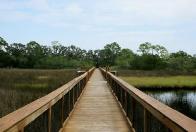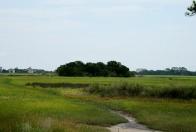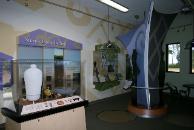Fort Mose Historic State Park - St. Augustine, Florida
Fort Mose Historic State Park - St. Augustine, Florida
Fort Mose Historic State Park
The clump of trees in the center of
the photograph is the site of Fort
Mose, the first community for free
blacks in what is now the United
States.
The clump of trees in the center of
the photograph is the site of Fort
Mose, the first community for free
blacks in what is now the United
States.
| Boardwalk to Fort Mose A boardwalk leads through the stunning marshes to an overlook where visitors can view the remains of Fort Mose, a landmark site in American history. |
Artist's View of Fort Mose
An interpretive panel at the site
features an artist's rendering of the
likely appearance of one of the two
outposts named Fort Mose.
An interpretive panel at the site
features an artist's rendering of the
likely appearance of one of the two
outposts named Fort Mose.
Boardwalk at Fort Mose
The boardwalk leading to the Fort
Mose overlook is a great place to
view birds and other wildlife. It
crosses beautiful tidal marshes.
The boardwalk leading to the Fort
Mose overlook is a great place to
view birds and other wildlife. It
crosses beautiful tidal marshes.
Site of Fort Mose
Coastal marshes now cover fields
that once supplied food for the
people of Fort Mose. The site of the
fort is marked by the trees in the
center of the photograph.
Coastal marshes now cover fields
that once supplied food for the
people of Fort Mose. The site of the
fort is marked by the trees in the
center of the photograph.
FORT MOSE HISTORIC STATE PARK
St. Augustine, Florida
St. Augustine, Florida
1st Free Black Community in U.S.



Caught up in the fun and excitement of the
Old World charms of St. Augustine, the
nation's oldest city, many visitors overlook a
Florida state park on the northern edge of the
city that preserves one of the most important
historic sites in the United States.
Fort Mose Historic State Park is the site of the
first free black community in what is now the
United States. Established in 1738 by the
Spanish to serve as a first line of defense
against the English in Georgia and South
Carolina, Fort Mose was called El Pueblo de
Gracia Real de Santa Teresa de Mose by the
Spanish officials in St. Augustine.
The concept of the settlement at Fort Mose
had been building for a long time by 1738. As
English colonies spread across much of the
South and as the supply of American Indian
slaves to work for the British ran out because
of the near or total annihilation of many tribes
in Florida and elsewhere in the South, the
English turned to importing African slaves in
larger and larger numbers.
Learning that they would be set free if they
could escape to Spanish Florida in exchange
for serving in the militia and adopting the
Catholic faith, many began to slip away from
the English and make their way across the
border. Among these was an African leader
named Francisco Menendez. Born in Africa,
the native of the Mandingo area, slipped
away from bondage and made his way to
Florida, where he eventually became the
leader of the black militia in St. Augustine.
Colonial records reveal that there were 100
of these former slaves living in St. Augustine
by 1738. Almost all of them had been taken
from freedom to serve the British in America.
Hoping to reward them for their loyalty with
permanent homes of their own and also
envisioning a strong settlement of free
blacks as a major defense for the city itself,
the Spanish joined with them in building a
strong fort of logs and earth two miles north
of the city gates.
The move was prompted by military
necessity. The English had just established
Fort Frederica and a chain of other defenses
along the coastal islands of Georgia. There
was great tension between Spain and
England and authorities in St. Augustine
rightfully worried for the safety of the city.
In the area surrounding the fort, the free
Africans cleared fields, built homes and
established a successful settlement. It did
not last long.
Just one year after Fort Mose was built, the
War of Jenkins' Ear erupted between Spain
and England. Named for the severed ear of
an English sea captain who had been taken
prisoner by the Spanish, the war quickly
spread to America. In March of 1740, General
James Oglethorpe invaded Florida and
attacked St. Augustine.
Forewarned of the attack, the Spanish
evacuated the inhabitants of Fort Mose into
the city itself and then watched as the
English overran the fort and set up cannon
across Matanzas Bay on Anastasia Island to
bombard the Castillo de San Marcos and
other main defenses of St. Augustine.
As the long siege developed, Oglethorpe
stationed a force of 137 men at Fort Mose to
prevent the Spanish in St. Augustine from
coming out to forage or collect horses. It was
a dangerous move and did not come without
consequences.
During the pre-dawn hours of June 26, 1740,
the Spanish launched a surprise attack on
Fort Mose. Among the 300 soldiers sent out
to attack the fort were Francisco Menendez
and the men of the free black militia. Later
recognized for his role in the Battle of Fort
Mose, Menendez and his men fought side by
side with the other Spanish troops as they
stormed the fort in bloody fighting. Of the
original 137 Britsh soldiers at Fort Mose, 68
were killed and 34 taken prisoner. The fort
itself was destroyed.
Old World charms of St. Augustine, the
nation's oldest city, many visitors overlook a
Florida state park on the northern edge of the
city that preserves one of the most important
historic sites in the United States.
Fort Mose Historic State Park is the site of the
first free black community in what is now the
United States. Established in 1738 by the
Spanish to serve as a first line of defense
against the English in Georgia and South
Carolina, Fort Mose was called El Pueblo de
Gracia Real de Santa Teresa de Mose by the
Spanish officials in St. Augustine.
The concept of the settlement at Fort Mose
had been building for a long time by 1738. As
English colonies spread across much of the
South and as the supply of American Indian
slaves to work for the British ran out because
of the near or total annihilation of many tribes
in Florida and elsewhere in the South, the
English turned to importing African slaves in
larger and larger numbers.
Learning that they would be set free if they
could escape to Spanish Florida in exchange
for serving in the militia and adopting the
Catholic faith, many began to slip away from
the English and make their way across the
border. Among these was an African leader
named Francisco Menendez. Born in Africa,
the native of the Mandingo area, slipped
away from bondage and made his way to
Florida, where he eventually became the
leader of the black militia in St. Augustine.
Colonial records reveal that there were 100
of these former slaves living in St. Augustine
by 1738. Almost all of them had been taken
from freedom to serve the British in America.
Hoping to reward them for their loyalty with
permanent homes of their own and also
envisioning a strong settlement of free
blacks as a major defense for the city itself,
the Spanish joined with them in building a
strong fort of logs and earth two miles north
of the city gates.
The move was prompted by military
necessity. The English had just established
Fort Frederica and a chain of other defenses
along the coastal islands of Georgia. There
was great tension between Spain and
England and authorities in St. Augustine
rightfully worried for the safety of the city.
In the area surrounding the fort, the free
Africans cleared fields, built homes and
established a successful settlement. It did
not last long.
Just one year after Fort Mose was built, the
War of Jenkins' Ear erupted between Spain
and England. Named for the severed ear of
an English sea captain who had been taken
prisoner by the Spanish, the war quickly
spread to America. In March of 1740, General
James Oglethorpe invaded Florida and
attacked St. Augustine.
Forewarned of the attack, the Spanish
evacuated the inhabitants of Fort Mose into
the city itself and then watched as the
English overran the fort and set up cannon
across Matanzas Bay on Anastasia Island to
bombard the Castillo de San Marcos and
other main defenses of St. Augustine.
As the long siege developed, Oglethorpe
stationed a force of 137 men at Fort Mose to
prevent the Spanish in St. Augustine from
coming out to forage or collect horses. It was
a dangerous move and did not come without
consequences.
During the pre-dawn hours of June 26, 1740,
the Spanish launched a surprise attack on
Fort Mose. Among the 300 soldiers sent out
to attack the fort were Francisco Menendez
and the men of the free black militia. Later
recognized for his role in the Battle of Fort
Mose, Menendez and his men fought side by
side with the other Spanish troops as they
stormed the fort in bloody fighting. Of the
original 137 Britsh soldiers at Fort Mose, 68
were killed and 34 taken prisoner. The fort
itself was destroyed.
Faced with such stiff resistance and unable
to reduce the massive walls of the Castillo
de San Marcos with his cannon, Oglethorpe
finally ended the siege and returned to
Georgia. The Spanish struck back two years
later, but were defeated at the Battle of
Bloody Marsh on St. Simons Island.
Twelve years passed before the Spanish
could again rebuild Fort Mose. In 1752,
however, a second fort was finally completed
just northeast of the ruins of the original fort.
The free African villagers lived here in peace
until 1763, when Florida was surrendered to
Great Britain at the end of the Seven Years
War, which was known in America as the
French and Indian War.
The inhabitants of Fort Mose evacuated
Florida with most of the other Spanish
citizens and resettled in Cuba, where their
descendants live to this day. The coastal
marshes eventually claimed the sites of the
two forts and for many years the site was a
lost and almost forgotten part of Florida
history.
All of that changed when Jack Williams, a St.
Augustine land-owner, became convinced
that Fort Mose had stood on his property. He
invited archaeologists to investigate and was
quickly proved correct.
A National Historic Landmark, the site of
America's first free black community is now
preserved at Fort Mose Historic State Park.
The park is located at 15 Fort Mose Trail in
St. Augustine and is open from 8 a.m. until
sunset daily. The museum/visitor center is
open from 9 a.m. to 5 p.m. Thursday through
Monday. Although the museum is closed on
Tuesdays and Wednesdays, the grounds
remain open. There is a $2 fee to visit the
museum.
In addition to the museum, the park offers
picnicking, interpretive displays and a board-
walk leading through the beautiful marshes
to an overlook where the site of the original
settlement can be seen.
To reach the park from St. Augustine, travel
north on San Marcos Ave. (U.S. Highway 1).
Just after Highway 1 and Highway A1A split,
watch for the brown Fort Mose sign and turn
right on Fort Mose Trail. The street ends at
the park address, 15 Fort Mose Trail.
Please click here for more information on
visiting historic Fort Mose.
to reduce the massive walls of the Castillo
de San Marcos with his cannon, Oglethorpe
finally ended the siege and returned to
Georgia. The Spanish struck back two years
later, but were defeated at the Battle of
Bloody Marsh on St. Simons Island.
Twelve years passed before the Spanish
could again rebuild Fort Mose. In 1752,
however, a second fort was finally completed
just northeast of the ruins of the original fort.
The free African villagers lived here in peace
until 1763, when Florida was surrendered to
Great Britain at the end of the Seven Years
War, which was known in America as the
French and Indian War.
The inhabitants of Fort Mose evacuated
Florida with most of the other Spanish
citizens and resettled in Cuba, where their
descendants live to this day. The coastal
marshes eventually claimed the sites of the
two forts and for many years the site was a
lost and almost forgotten part of Florida
history.
All of that changed when Jack Williams, a St.
Augustine land-owner, became convinced
that Fort Mose had stood on his property. He
invited archaeologists to investigate and was
quickly proved correct.
A National Historic Landmark, the site of
America's first free black community is now
preserved at Fort Mose Historic State Park.
The park is located at 15 Fort Mose Trail in
St. Augustine and is open from 8 a.m. until
sunset daily. The museum/visitor center is
open from 9 a.m. to 5 p.m. Thursday through
Monday. Although the museum is closed on
Tuesdays and Wednesdays, the grounds
remain open. There is a $2 fee to visit the
museum.
In addition to the museum, the park offers
picnicking, interpretive displays and a board-
walk leading through the beautiful marshes
to an overlook where the site of the original
settlement can be seen.
To reach the park from St. Augustine, travel
north on San Marcos Ave. (U.S. Highway 1).
Just after Highway 1 and Highway A1A split,
watch for the brown Fort Mose sign and turn
right on Fort Mose Trail. The street ends at
the park address, 15 Fort Mose Trail.
Please click here for more information on
visiting historic Fort Mose.
Castillo de San Marcos National Monument
Fort Matanzas National Monument
St. Augustine, Florida
Historic Sites & Points of Interest
Fort Frederica National Monument
Battle of Bloody Marsh, Georgia
Fort Gadsden and the "Negro Fort"
Historic Sites in Florida
Forts & Battlefields of the South
Explore other Southern Historic Sites
Fort Matanzas National Monument
St. Augustine, Florida
Historic Sites & Points of Interest
Fort Frederica National Monument
Battle of Bloody Marsh, Georgia
Fort Gadsden and the "Negro Fort"
Historic Sites in Florida
Forts & Battlefields of the South
Explore other Southern Historic Sites


Museum at Fort Mose
Exhibits in the visitor center tell the
story of the two forts and of the
settlement that surrounded them.
Artifacts found by archaeologists
are on display.
Exhibits in the visitor center tell the
story of the two forts and of the
settlement that surrounded them.
Artifacts found by archaeologists
are on display.

Custom Search
| Copyright 2011, 2013, 2014 & 2015 by Dale Cox All rights reserved. Last Update: January 3, 2015. |
Historic Forts in Florida
Advanced Redoubt of Fort Barrancas
Bateria de San Antonio
Fort Barrancas (Gulf Islands National Seashore)
Fort Caroline National Memorial
Fort Clinch State Park
Fort Cooper State Park
Fort DeSoto Historic Park
Fort Fanning Historic Site
Fort Gadsden Historic Site
Fort Pickens (Gulf Islands National Seashore)
Bateria de San Antonio
Fort Barrancas (Gulf Islands National Seashore)
Fort Caroline National Memorial
Fort Clinch State Park
Fort Cooper State Park
Fort DeSoto Historic Park
Fort Fanning Historic Site
Fort Gadsden Historic Site
Fort Pickens (Gulf Islands National Seashore)

